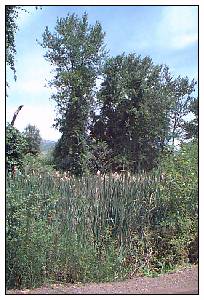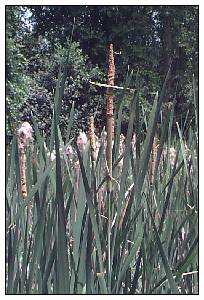 Talent Station 2: A Place in Transition
Talent Station 2: A Place in Transition
Talent Station 2: A Place in Transition


MANY WETLANDS are really ponds on their way to becoming dry land. As vegetation gradually fills in the pond, it traps soil, transforming the pond into a marsh and eventually into a meadow that will support trees and shrubs. This marsh is one of several along the path, most of which have cattails (Typha sp.), a familiar dweller of marshes and backwaters. In spring, the soft yellow cluster at the tip of the spike is the male flower; the more noticeable fluffy brown mass below it is the female flower. After pollination, the female flower develops into innumerable seeds packed together and covered with hairs. Indians used cattail fluff for padding cradles and dressing wounds. The pollen can be used for making bread and the young shoots can be eaten raw or cooked. The starchy roots are also edible, and can be roasted, boiled, or dried and ground into flour.
One of the most common inhabitants of the marsh is the red-winged blackbird. Smaller than a robin, the males are all black except for red shoulder patches. In spring they arrive in flocks and begin nesting. In courtship, males typically perch on a cattail, spread their tails, half open their wings, and ruffle their feathers. The female builds a nest by weaving marsh vegetation around cattails and suspending it over the water for protection. Their call is a gurgled "konk-la-ree." The woody vine draped on the trees to the left is western wild grape (Vitis californica). It can grow up to 50 feet tall, entwining its host tree and eventually causing its death. The wild grape has poisonous roots but its fruit is edible and can be made into jelly or wine. The fall foliage is a beautiful yellow-orange.
The most common plant along the path is the blackberry. Imported from Eurasia, the Himalayan berry (Rubus procerus) is a formibable weed. Armed with long hooked barbs, it clambers over other plants and smothers them. The blackberry has both a deep, tough root system and efficient seed dispersal. Birds prize the berries and spread them far and wide. The brambles also provide good cover for the birds. The ability to root when the tips of the canes bend down and contact the soil ensures its spread over wide areas. Berry pickers everywhere love this plant, but it can be a serious deterrent to forest regeneration because of its invasive habit.
















Drawings by Tonia Blum.
Photos by D.L. Mark